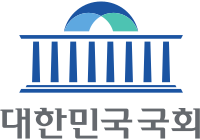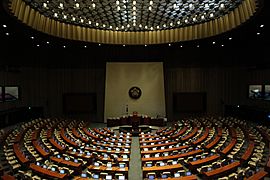National Assembly (South Korea) facts for kids
Quick facts for kids National Assembly of theRepublic of Korea 대한민국 국회 大韓民國國會 Daehanminguk Gukhoe |
|
|---|---|
| 21st National Assembly | |
 |
|
 |
|
| Type | |
| Type | |
| Leadership | |
|
Speaker
|
Kim Jin-pyo, Independent
Since 4 July 2022 |
|
Deputy Speaker
|
Kim Young-joo, Democratic
Since 4 July 2022 |
|
Deputy Speaker
|
Chung Woo-taik, People Power
Since 10 November 2022 |
| Structure | |
| Seats | 300 |
|
|
|
|
Political groups
|
Government (115)
Supported by (1)
Opposition (183)
Vacant (1)
|
|
Length of term
|
4 years |
| Salary | US$128,610 |
| Elections | |
| Parallel voting: First past the post (FPTP) (253 seats) Proportional Representation (PR) with 3% electoral threshold (Largest remainder method) (17 seats) Additional member system (30 seats) |
|
|
Last election
|
15 April 2020 |
|
Next election
|
17 April 2024 (expected) |
| Meeting place | |
 |
|
| Main Conference Room National Assembly Building, Seoul 37°31′55.21″N 126°54′50.66″E / 37.5320028°N 126.9140722°E |
|
| Website | |
| korea.assembly.go.kr | |
The National Assembly of the Republic of Korea is like the main parliament or law-making body for South Korea. It's often just called the National Assembly. This important group makes laws for the country.
Elections for the National Assembly happen every four years. The most recent elections were on April 15, 2020. The National Assembly has 300 members, or "seats." Most of these seats (253) are for people elected directly from different areas. The other 47 seats are given out based on how many votes a political party gets overall.
The South Korean constitution says there must be at least 200 members in the assembly. In 1990, there were 299 seats. People who want to be elected to the assembly must be at least 30 years old. Members of the National Assembly serve for four years. Unlike in some past governments, the President of South Korea cannot close down the assembly.
Contents
Who is in the National Assembly?
| Group | Floor leader | Seats | % of seats | ||||
|---|---|---|---|---|---|---|---|
| ▌Democratic Party | Lee Jae-myung | 176 | 52.31% | ||||
| ▌People Power | Yoon Jae-ok | 108 | 45.73% | ||||
| ▌Green-Justice | Sim Sang-jung | 6 | 1.8% | ||||
| ▌New Future | Kim Jong-min | 5 | 1.5% | ||||
| ▌New Reform | Yang Hyang-ja | 4 | 1.2% | ||||
| ▌Progressive | Kang Sung-hee | 1 | 0.3% | ||||
| ▌Rebuilding Korea Party | Hwang Un-ha | 1 | 0.3% | ||||
| ▌Liberal Unification Party | Hwangbo Seung-hee | 1 | 0.3% | ||||
| ▌Independents | 9 | 3.0% | |||||
| ▌Vacant | 3 | 0.9% | |||||
| Total | 300 | 100.0% | |||||
|
Notes:
|
|||||||
This section shows which political parties have members in the National Assembly right now. It helps you see how many members each party has.
How the National Assembly Works

The National Assembly has a special way of working to make sure everything runs smoothly.
The Speaker and Deputy Speakers
The assembly is led by a Speaker and two Deputy Speakers. Their job is to help the law-making process move forward. These leaders are chosen by the members of the assembly through a secret vote. They serve for two years. The Speaker must be fair and not favor any political party. The Speaker and Deputy Speakers cannot also be government ministers at the same time.
Groups for Discussion
Political parties that have at least 20 members in the assembly can form "negotiation groups." These groups get special rights that smaller parties don't have. For example, they receive more money from the government. They also get to join important meetings where the assembly's plans are decided.
How Laws are Made
To suggest a new law, a member of the assembly needs to get at least ten other members to sign their idea. This idea is called a "bill." Then, a special committee checks the bill to make sure it's written clearly and correctly. After that, the assembly can vote to approve or reject the bill.
Committees: Working in Smaller Groups
There are 17 standing committees in the National Assembly. These committees are like smaller teams. They look closely at bills and requests that are related to their specific topics. They also do other tasks that are set by the laws.
Here are some of the committees:
- House Steering Committee
- Legislation and Judiciary Committee
- National Policy Committee
- Strategy and Finance Committee
- Science, ICT, Future Planning, Broadcasting and Communications Committee
- Education Committee
- Culture, Sports and Tourism Committee
- Foreign Affairs and Unification Committee
- National Defense Committee
- Security and Public Administration Committee
- Agriculture, Food, Rural Affairs, Oceans and Fisheries Committee
- Trade, Industry and Energy Committee
- Health and Welfare Committee
- Environment and Labor Committee
- Land, Infrastructure and Transport Committee
- Intelligence Committee
- Gender Equality and Family Committee
How Members are Elected
The National Assembly has 300 seats. Most of these (253) are filled by a system called "First-past-the-post voting" (FPTP). This means the person with the most votes in an area wins. The other 47 seats are "proportional representation" seats. These are given to parties based on their overall vote percentage.
In 2019, there was a change to how these proportional seats are given out. However, for the 2020 election, 17 of these seats were still given using an older method.
To get proportional representation seats, a party must get at least 3% of all votes or win at least 5 direct seats. A special math formula decides how many seats each eligible party gets. If there's a tie, a lottery decides the winner.
The voting age in South Korea was also changed from 19 to 18 years old. This allowed over half a million more young people to vote!
Images for kids
See also
 In Spanish: Asamblea Nacional de Corea del Sur para niños
In Spanish: Asamblea Nacional de Corea del Sur para niños






